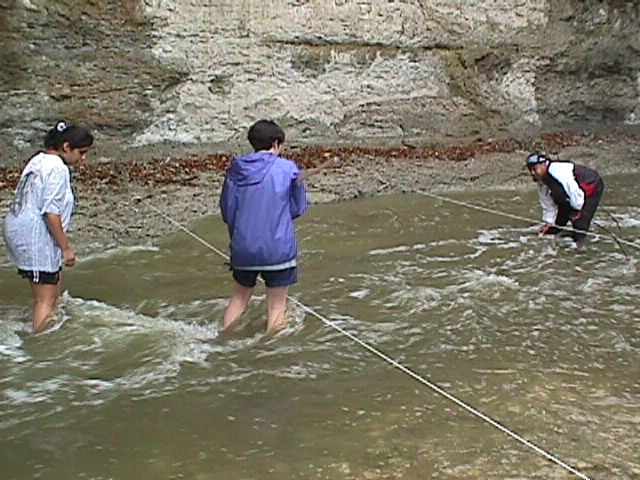



Next: How Real-Time Stream Gauges
Up: Lab2 Background
Previous: Measuring Cross-Sectional Area
Subsections
Velocity can be measured directly, using a flowmeter (essentially a
speedometer for water, Fig. 3.8 and Section
3.1.3) or inferred by timing the movement of a float in
the water (Fig. 3.5). Velocity varies across a stream
and with depth, depending primarily on the proximity of the streambed
(Fig. 3.4). When using a flowmeter, a single
measurement at approximately 60% of the depth of the stream will give
a reliable vertical average.
Figure 3.4:
Variation of stream
velocity with depth (after Fig. 3.16, Sanders, 1998).
|
|
Figure 3.5:
The float
method for velocity determination (after Fig. 3.17,
Sanders, 1998).
|
|
Figure 3.6:
Students using the float method for velocity measurement
(click on image for full-sized version). Fall '98 class, at Spring
Creek, Richardson, Texas.
|
|
Using the Flowmeter
The flowmeter can be used to determine average velocity at a point, or
across the entire stream (for small streams). The device is
waterproof, but try to avoid submerging the LCD display. To use the
flowmeter to measure stream velocity:
- make sure the prop turns freely
- note the measurement units, ``mi'' on the lower right side of
the display denotes english (ft/sec) units, ``km'' denotes
metric (m/sec)
- point the prop directly along the flow, with the black arrow on the
prop housing pointing downstream (with the flow). The prop
should be fully submerged.
- press the right button until ``V'' (velocity) appears
The instantaneous velocity (in meters/sec) is displayed as
the top number on the LCD screen.
- press the left button to set the lower display to ``av'' for
average velocity (initially this number is the maximum ``mx''
velocity)
- press and hold both left and right buttons simultaneously for
2 seconds to zero the display, and start measurement
- for point measurements, hold in the flow until the average
velocity is constant, then remove the probe. Measurement
(averaging) ceases when the prop stops turning, so the displayed
value is the true average at the point.
- for areal measurements (average
velocity over a stream
cross-section) move the probe in the flow in a steady
back-and-forth motion, as if you were spray-painting. When the
entire cross-section has been covered, remove the probe from the
flow, and record the displayed value.
Figure 3.7:
Impeller flowmeter. After
http://www.globalw.com/graphics/flow.jpg.
|
|
Figure 3.8:
Students using an
impeller flowmeter (click on image for full-sized version). Fall '98
class, at Spring Creek, Richardson, Texas.
![\begin{figure}\centering\includegraphics[height=3in,bb=0 0 639 479]
{Figs/flowmeter_use.eps.gz}\end{figure}](Timg15.gif) |




Next: How Real-Time Stream Gauges
Up: Lab2 Background
Previous: Measuring Cross-Sectional Area
GEOS 3110 Professor's Notes, Summer 2003
Dr. T. Brikowski, UTD


![\begin{figure}\centering\includegraphics[height=3in,bb=0 0 639 479]
{Figs/flowmeter_use.eps.gz}\end{figure}](Timg15.gif)